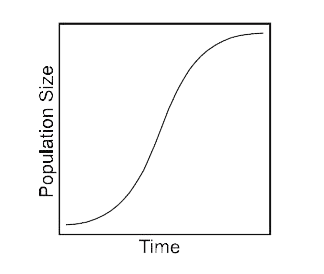A population growing in a habitat with limited resources shows four phases of growth in the following sequence -
Acceleration - Deceleration - Lag phase Asymptote
Asymptote - Acceleration - Deceleration - Lag phase
Lag phase - Acceleration - Deceleration - Asymptote
Acceleration - Lag phase - Deceleration - Asymptote
The correct Answer is:C
To solve the question regarding the four phases of population growth in a habitat with limited resources, we can break down the solution into clear steps:
1. Understanding Population Growth Phases:
- When a population grows in a habitat with limited resources, it typically goes through four distinct phases. These phases are characterized by different growth rates and patterns.
2. Identifying the First Phase - Lag Phase:
- The first phase of growth is known as the Lag Phase. During this phase, the population experiences very slow growth as it acclimatizes to the new environment and resources are limited.
3. Identifying the Second Phase - Exponential Phase:
- Following the lag phase, the population enters the Exponential Phase (also referred to as the Acceleration Phase or Log Phase). In this phase, the growth rate increases rapidly as resources become more available, leading to maximum growth.
4. Identifying the Third Phase - Deceleration Phase:
- After the exponential phase, the population experiences a Deceleration Phase. In this phase, the growth rate begins to decline as resources become more limited and competition increases.
5. Identifying the Fourth Phase - Stationary Phase:
- The final phase is the Stationary Phase (also known as the Asymptote Phase). In this phase, the population size stabilizes as the birth rate equals the death rate, resulting in no significant growth or decline.
6. Summarizing the Sequence:
- The correct sequence of the four phases of population growth in a habitat with limited resources is:
- 1st: Lag Phase
- 2nd: Exponential Phase
- 3rd: Deceleration Phase
- 4th: Stationary Phase
7. Choosing the Correct Option:
- Based on the identified phases, the correct answer to the question is Option 3, which correctly lists the phases in the order: Lag Phase, Exponential Phase, Deceleration Phase, and Stationary Phase.
Final Answer:
The correct sequence of the four phases of population growth is:
1. Lag Phase
2. Exponential Phase
3. Deceleration Phase
4. Stationary Phase
- When a population grows in a habitat with limited resources, it typically goes through four distinct phases. These phases are characterized by different growth rates and patterns.
- The first phase of growth is known as the Lag Phase. During this phase, the population experiences very slow growth as it acclimatizes to the new environment and resources are limited.
- Following the lag phase, the population enters the Exponential Phase (also referred to as the Acceleration Phase or Log Phase). In this phase, the growth rate increases rapidly as resources become more available, leading to maximum growth.
- After the exponential phase, the population experiences a Deceleration Phase. In this phase, the growth rate begins to decline as resources become more limited and competition increases.
- The final phase is the Stationary Phase (also known as the Asymptote Phase). In this phase, the population size stabilizes as the birth rate equals the death rate, resulting in no significant growth or decline.
- The correct sequence of the four phases of population growth in a habitat with limited resources is:
- 1st: Lag Phase
- 2nd: Exponential Phase
- 3rd: Deceleration Phase
- 4th: Stationary Phase
- Based on the identified phases, the correct answer to the question is Option 3, which correctly lists the phases in the order: Lag Phase, Exponential Phase, Deceleration Phase, and Stationary Phase.
The correct sequence of the four phases of population growth is:
1. Lag Phase
2. Exponential Phase
3. Deceleration Phase
4. Stationary Phase
Topper's Solved these Questions
Similar Questions
A population of organism growing in a habitat with limited resources
View SolutionAssertion : A population growing in a habitat with limited resources shows initially a lag phase, followed by phase of accelerated and deceleration and finally as asymptote, when the population density reaches the carrying capacity.
Reason : In Verhulst-Pearl Logistic growth, plot of N (population density) at time (t) results in a sigmoid curve.
View Solution
Knowledge Check
If a population grows in a habitat with limited resources , then following phases of achievement observed
ALag → Acceleration → Deceleration → AsymptoteBLog → Deceleration → Acceleration → AsymptoticCLog → Acceleration → Deceleration → AsymptoticDLag → Acceleration → Asymptotic → DecelerationA population growting in a habitat with …….A……. Resource show initially a …….B……..phase, followed by an asymptote , when the population density reaches the ………C…….
Choose the correct optioin for A,B and CAA-limited, B-lar,phase,C-carrying capacityBA-limited B-statonary phase,C-carrying capacityCA-unlimted ,B-lar phase,Carrying capacityDA-unlimted , B-log phase, C-carrying capacityCorrect sequence of different phases of growth is
ACell division → Cell differentiation → Cell elongationBCell differentiation → Cell division → Cell elongationCCell elongation → Cell division → Cell differentiationDCell division → Cell elongation → Cell differentiation.
" If four percent of a population shows a recessive trait,what will be the frequency of carriers in the following generation "
View Solutionwhich of the following option is true for verhulst Pearl logistic growth?
(A)population growth is decreased by the equation dNdt=rN[KK−N].
(B) r' represents biotic potential.
(C) applicable to a population growing in habitat with limited resources.
(D)K represents carrying capacity
View SolutionThe difference
P: and development on the other affects
Q: in the relationship death and birth rates on the one hand
R: but the age structure of the population
S: not just the rate of population growth
Which one of the following is the correct sequence?
View SolutionMany population colonising a new habitat show a logistic population growth pattern over time, as shown in the figure below.

In such a population, the POPULATION growth rate
View SolutionIn a growing plant, the first phase during the process of growth is
View Solution